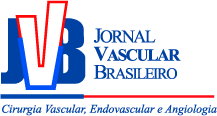Taxa de oclusão em veias safenas pós-endolaser de 1.470 nm e efeitos colaterais no seguimento de 1 ano
Rate of saphenous vein occlusion and side effects at 1 year follow up after 1470 nm endolaser
Leonardo Zelotti Movio; Marco Antônio Forastieri Mansano; Marcelo Eckert Zanoni; Nancy Christiane Ferreira Silva; Marcel Pereira Rangel
Resumo
Palavras-chave
Abstract
Background: Use of endolaser for chronic venous disease involves choosing the laser wavelength and optical fiber to use and the quantity of energy to be administered. Efficacy is assessed by the venous occlusion rate and safety is evaluated in terms of side effects.
Objectives: To determine the incidence of total post-endolaser saphenous vein occlusion at 1-year follow-up. To describe side effects and their incidence and rates of reintervention or supplementary treatment during the postoperative period.
Methods: A retrospective, observational cohort study with a quantitative approach, enrolling patients with saphenous vein incompetence treated with intravenous 1,470 nm laser ablation. Data were input to an MS Excel 2019 spreadsheet, calculating means and standard deviations with the software’s Power Query supplement.
Results: 38 patients and 104 venous segments were eligible for the study. 100% were occluded at 30 days and 99.04% were still occluded at 1 year after the procedure. Mean Linear Endovenous Energy Density administered to the internal saphenous vein was 2,040.52 W/cm/s with standard deviation of ± 1,510.06 W/cm/s and 1,168.4 W/ cm/s with standard deviation of ± 665.011 W/cm/s was administered to the external saphenous vein. Pain along the saphenous path was the most common side effect, with eight cases (21.05%), followed by one case of paresthesia (2.63%).
Conclusions: The total occlusion rate at 1-year follow-up suggests the technique is promising and is currently applicable in this sample. The incidence of pain and paresthesia may be caused by the high mean energy delivered in some cases. It is recommended that multicenter studies be conducted with larger and more uniform samples in terms of their Clinical-Etiological-Anatomical-Pathological classifications.
Keywords
References
1 Youn YJ, Lee J. Chronic venous insufficiency and varicose veins of the lower extremities. Korean J Intern Med. 2019;34(2):269-83.
2 Eberhardt RT, Raffetto JD. Chronic venous insufficiency. Circulation. 2014;130(4):333-46.
3 Robertson L, Evans C, Fowkes FG. Epidemiology of chronic venous disease. Phlebology. 2008;23(3):103-11.
4 Maffei FH, Magaldi C, Pinho SZ, et al. Varicose veins and chronic venous insufficiency in Brazil: prevalence among 1755 inhabitants of a country town. Int J Epidemiol. 1986;15(2):210-7.
5 Vuylsteke ME, Klitfod L, Mansilha A. Endovenous ablation. Int Angiol. 2019;38(1):22-38.
6 Raetz J, Wilson M, Collins K. Varicose veins: diagnosis and treatment. Am Fam Physician. 2019;99(11):682-8. PMid:31150188.
7 Galanopoulos G, Lambidis C. Minimally invasive treatment of varicose veins: endovenous laser ablation (EVLA). Int J Surg. 2012;10(3):134-9.
8 van den Bremer J, Moll FL. Historical overview of varicose vein surgery. Ann Vasc Surg. 2010;24(3):426-32.
9 Hamdan A. Management of varicose veins and venous insufficiency. JAMA. 2012;308(24):2612-21.
10 Gloviczki P, Comerota AJ, Dalsing MC, et al. The care of patients with varicose veins and associated chronic venous diseases: clinical practice guidelines of the Society for Vascular Surgery and the American Venous Forum. J Vasc Surg. 2011;53(5, Suppl):2S-48S.
11 Silva APP, Pinto DM, Milagres VAMV, Bez LG, Maciel JCA, Lopes CS. Results of venous reflux treatment with 1,470 nm endolaser and correlation with degree of venous insufficiency. J Vasc Bras. 2021;20:e20200172.
12 Hulley SB, Cummings SR, Browner WS, Grady DG, Newman TB. Delineando a Pesquisa Clínica: uma abordagem epidemiológica. In: Browner WS, Newman TB, Hulley SB, Estimando o tamanho de amostra e o poder estatístico. Porto Alegre: Artmed; 2015. p. 91-103.
13 von Elm E, Altman DG, Egger M, et al. The Strengthening the Reporting of Observational Studies in Epidemiology (STROBE) statement: guidelines for reporting observational studies. PLoS Med. 2007;4(10):e296.
14 de Araujo WJB, Timi JRR. Análise histológica e imuno-histoquímica da veia safena magna submetida a termoablação com laser em modelo ex vivo, utilizando diferentes comprimentos de onda e densidades de energia linear endovenosa [tese]. Curitiba: Programa de Pós-Graduação em Clínica Cirúrgica, Setor de Ciências da Saúde, Universidade Federal do Paraná; 2018.
15 Pavei P, Spreafico G, Bernardi E, Giraldi E, Ferrini M. Favorable long-term results of endovenous laser ablation of great and small saphenous vein incompetence with a 1470-nm laser and radial fiber. J Vasc Surg Venous Lymphat Disord. 2021;9(2):352-60.
16 Aktas AR, Celik O, Ozkan U, et al. Comparing 1470- and 980-nm diode lasers for endovenous ablation treatments. Lasers Med Sci. 2015;30(5):1583-7.
17 Malskat WS, Poluektova AA, van der Geld CW, et al. Endovenous laser ablation (EVLA): a review of mechanisms, modeling outcomes, and issues for debate. Lasers Med Sci. 2014;29(2):393-403.
18 Galego GN, Lima GBB, Franklin RN, Bortoluzzi CT, Silveira PG. Resultado do tratamento da insuficiência venosa superficial com Laser Diodo 1470 nm. J Vasc Bras. 2015;14(2):115-22.
19 Mazayshvili K, Akimov S. Early complications of endovenous laser ablation. Int Angiol. 2019;38(2):96-101.
20 Pannier F, Rabe E, Rits J, Kadiss A, Maurins U. Endovenous laser ablation of great saphenous veins using a 1470 nm diode laser and the radial fibre--follow-up after six months. Phlebology. 2011;26(1):35-9.
21 Malskat WS, Giang J, De Maeseneer MG, Nijsten TE, van den Bos RR. Randomized clinical trial of 940- versus 1470-nm endovenous laser ablation for great saphenous vein incompetence. Br J Surg. 2016;103(3):192-8.
22 Schwarz T, von Hodenberg E, Furtwängler C, Rastan A, Zeller T, Neumann FJ. Endovenous laser ablation of varicose veins with the 1470-nm diode laser. J Vasc Surg. 2010;51(6):1474-8.
Submitted date:
10/07/2021
Accepted date:
05/05/2023



